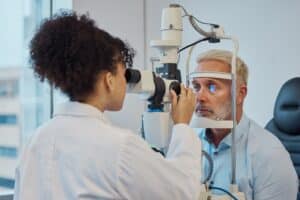There are an abundance of procedures that can be done to improve your eyesight. A few extremely popular options are PRK eye surgery, LASIK eye surgery, and SMILE eye surgery. Each procedure has the same goal and its own host of benefits. But deciding which one is the best option for you can be difficult. Many of our patients want to compare PRK vs LASIK vs SMILE.
Let’s discuss how each of these procedures is performed, when they’re a good option, and what their downsides are. Then, with the help of an eye specialist, you will be able to decide which surgery is best for you.
Table of Contents
What is PRK Eye Surgery?
PRK eye surgery, also known as photorefractive keratectomy, is a procedure that involves ablating the top layer of the cornea. During the PRK procedure, the outer layer of the cornea is removed, and then the cornea is reshaped using a cool excimer laser. The surgery is an outpatient procedure, and the treatment only takes about five minutes per eye.
When is PRK a Good Option?
PRK eye surgery is used to treat:
- Myopia (nearsightedness)
- Hyperopia (farsightedness)
- Astigmatism
This procedure can be beneficial for those with thin corneas and higher eye prescriptions, as well as those who participate in contact sports in which a lot of direct contact is made with the eyes. PRK can also be used to enhance a previous LASIK patient’s distance vision.
Downsides of PRK
The biggest downside of PRK eye surgery is the recovery time. It has a longer recovery time than both SMILE and LASIK. It takes about a week for the cells on the outer layer of your cornea to grow back, and then can take anywhere from two to six weeks for the cells to smooth over and offer clear vision.
If this surgery is performed on both eyes at the same time, you will need to take off at least a week from driving and working.
What is LASIK Eye Surgery?
LASIK, or Laser-Assisted In-situ Keratomileusis, is one of the most well-known vision correction surgeries. During the procedure, a small flap of corneal tissue is created using a femtosecond laser and is folded back. Then, an excimer laser is used to reshape the underlying corneal tissue.
When is LASIK a Good Option?
LASIK can be used to treat:
- Myopia
- Hyperopia
- Astigmatism
It’s an excellent option for those who need a quick healing time. The majority of patients are able to return to work and drive the day after their procedure.
This procedure is a great choice if you:
- Are 21 years or older
- Have good eye and general health
- At least one year of stable prescriptions
Downsides of LASIK
Unfortunately, not everyone is a candidate for LASIK. If you have thin or irregular corneas or are predisposed to chronic dry eye symptoms, the other options will be better for you.
LASIK is also a more complex surgery, which could open your eyes up to post-surgery, flap-related complications, though it is very rare.
These complications could include:
- Striae
- Irregular astigmatism
- Epithelial ingrowth
- Inflammation
- Dry eye syndrome
What is SMILE Eye Surgery?
SMILE eye surgery is the most recently FDA-approved procedure. In this procedure, unlike the others, an excimer laser is not utilized. Instead, a femtosecond laser cuts a small incision in your cornea where the lenticule is removed. This helps to reshape the cornea and improve vision. This procedure usually takes about 15-20 minutes per eye.
When is SMILE a Good Option?
A SMILE procedure can be used to correct high levels of:
- Nearsightedness
- Astigmatism
When comparing SMILE vs LASIK, there are no risks of flap-related complications after surgery because SMILE is less invasive than LASIK with a smaller incision.
You could be a candidate for SMILE if you:
- Are 22 years or older
- Your eye prescription has not changed in the last year
- Your nearsightedness is between -1 and -10
- You have up to 3 diopters of astigmatism
- You have healthy corneas and overall eye health
Downsides of SMILE
The big downside to SMILE is that it’s not yet available to treat farsightedness. It also has a recovery time of one to two days, which is a slightly longer recovery time than LASIK. It is still faster than PRK recovery, however.
Which Procedure is Best For Me?
Ultimately, the best laser eye surgery for you is best determined by yourself and one of the many knowledgeable professionals at Cleveland Eye Clinic. If you’re trying to compare PRK vs LASIK, or even are interested in SMILE, our team can give you the information that you need. If you’re interested in corrective eye surgery, schedule a free consultation with us today to learn more about your options and which procedure your particular eye needs would be best suited for.








